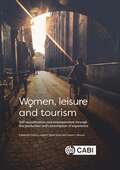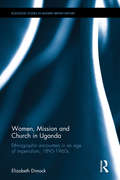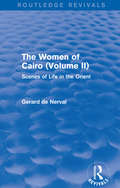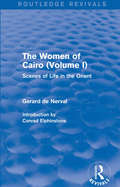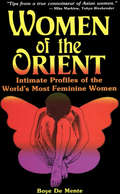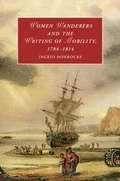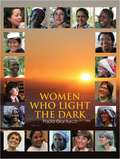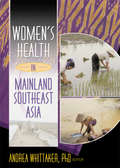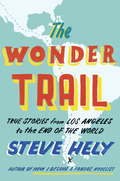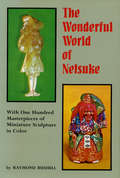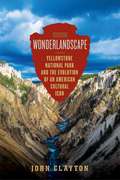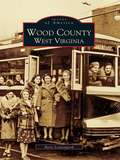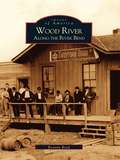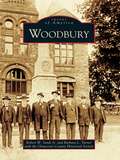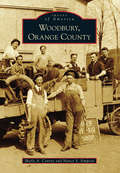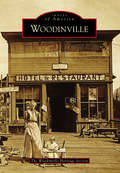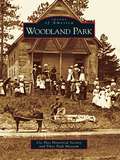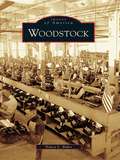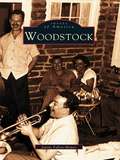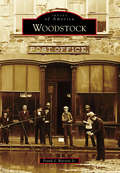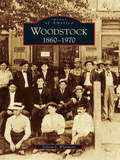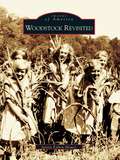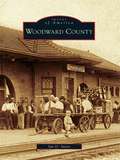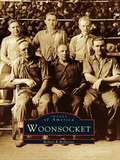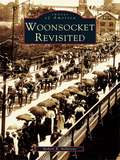- Table View
- List View
Women, Leisure and Tourism: Self-actualization and Empowerment through the Production and Consumption of Experience
by Linda J. Ingram, Klára Tarkó, Susan L. SlocumWomen, Leisure and Tourism provides a comprehensive discussion of women, leisure, and tourism through the lens of leisure production and consumption, both by women and for women. Specifically, this text includes a multi-cultural perspective to highlight the unique attributes leisure brings to women, the role of women in leisure entrepreneurship, and the creation of supportive, inclusive environments to enhance female well-being through the examination of these activities in often overlooked populations. The diversity of women's leisure and tourism practices is best perceived through the links between various leisure practices (e.g., sport, outdoor recreation, travel and tourism, learning, crafts, events, family leisure), as well as an understanding of leisure production across cultures and life stages. These chapters bring to the forefront many of the challenges inherent in providing leisure and tourism that support the diverse needs of women, as well as a look at female innovation that is also often overlooked in leisure research. The book includes examples of both applied and conceptual chapters from global perspectives in academic studies. This book: - Is written by multi-disciplinary authors. - Includes case studies, research methodologies and pedagogical approaches to highlight the complexity of gender studies and provide a diverse toolkit to support further research on women and gender. - Presents applied and conceptual chapters from global perspectives in academic studies. This book is valuable for academics and graduate students of tourism, leisure and gender studies.
Women, Mission and Church in Uganda: Ethnographic encounters in an age of imperialism, 1895-1960s (Routledge Studies in Modern British History)
by Elizabeth DimockThis volume recounts the experiences of female missionaries who worked in Uganda in and after 1895. It examines the personal stories of those women who were faced with a stubbornly masculine administration representative of a wider masculine administrative network in Westminster and other outposts of the British Empire. Encounters with Ugandan women and men of a range of ethnicities, the gender relations in those societies and relations between the British Protectorate administration and Ugandan Christian women are all explored in detail. The analysis is offset by the author’s experience of working in Uganda at the close of British Protectorate status in the 1960s, employed by the Uganda Government Education Department in a school founded by the Uganda Mission.
The Women of Cairo: Scenes of Life in the Orient (Routledge Revivals)
by Gerard De NervalThe Women of Cairo: Scenes of Life in the Orient, first published in 1929, describes the trip to Egypt and other locations in the Ottoman Empire taken by French Romanticist Gerard de Nerval. The book focuses on both reinforcing and dispelling the old ways in which people saw the Orient, as well as examining their old and new customs. This book is perfect for those studying history and travel.
The Women of Cairo: Scenes of Life in the Orient (Routledge Revivals)
by Gerard De NervalThe Women of Cairo: Scenes of Life in the Orient, first published in 1929, describes the trip to Egypt and other locations in the Ottoman Empire taken by French Romanticist Gerard de Nerval. The book focuses on both reinforcing and dispelling the old ways in which people saw the Orient, as well as examining their old and new customs. This book is perfect for those studying history and travel.
Women of the Orient
by Boye Lafayette De MenteFrom the hair color and style, body- type, shape to etiquette and level of femininity of oriental women, Boye de Mente takes the reader into full detail with Women of the Orient chapters including:The women of JapanThe women of KoreaThe women of Taiwan & Hong KongThe women of ThailandThe Women of VietnamAnd lastly the Women of the PhilippinesIn Women of the Orient, Boye De Mente, reveals Asia's exotic cities and explores the unique character and charms of some of the world's most feminine women. Learn how hot-tempered Korean girls keep warm on cold winter nights, what kind of hot dip is offered in Japan's so-called "Soaplands" and what goes on under the table in "Taiwan Roulette". All of this and more is discussed in a disarmingly frank manner, providing a host of insights for all girl watchers, apprentice and veteran alike.
Women Wanderers and the Writing of Mobility, 1784–1814 (Cambridge Studies in Romanticism)
by Ingrid HorrocksIn the last days of the Scandinavian journey that would become the basis of her great post-Revolutionary travel book, Mary Wollstonecraft wrote, 'I am weary of travelling - yet seem to have no home - no resting place to look to - I am strangely cast off'. From this starting point, Ingrid Horrocks reveals the significance of representations of women wanderers in the late-eighteenth and early-nineteenth centuries, particularly in the work of women writers. She follows gendered, frequently reluctant wanderers beyond travel narratives into poetry, gothic romances, and sentimental novels, and places them within a long history of uses of the more traditional literary figure of the male wanderer. Drawing out the relationship between mobility and affect, and illuminating textual forms of wandering, Horrocks shows how paying attention to the figure of the woman wanderer sheds new light on women and travel, and alters assumptions about mobility's connection with freedom.
Women Who Light the Dark
by Paola GianturcoFrom Book Jacket: Across the world, local women are helping one another tackle the problems that darken their lives-domestic violence, sex trafficking, war, poverty, illiteracy, discrimination, inequality, malnutrition, disease. These women may lack material resources, but they possess a wealth of an even more precious resource: imagination. And their imaginations light the dark. Women in Morocco create and produce plays that educate illiterate people about women's rights. Girls in Zimbabwe compose and perform poetry that shocks communities into fighting child rape. Teachers in India invent puppet shows that help homeless children understand AIDS. Brazilian math teachers inspire girls from the favelas to learn arithmetic by originating fashion shows. Lesbians in Argentina develop and stage street skits, demonstrating against discrimination. A master ballet teacher instructs a thousand poor Cuban children in classical dance. Sometimes imagination takes the form of innovative strategies. In Nepal, women teach their sisters to drive taxis and guide treks, and in Nicaragua, to become welders, carpenters, and electricians-all supposedly men's jobs. In Kenya, mothers get wells dug so their daughters can go to school instead of walking seven hours to fetch water. In Cameroun, medical specialists train traditional rulers and healers whose behavior has inadvertently spread AIDS to become health educators. In the United States, activists introduce women with disabilities to challenge courses, camping, whitewater rafting, and swimming, empowering them to lead others who are disabled. Travel with photojournalist Paola Gianturco to fifteen countries on five continents. Hear, in the women's own words, about their lives and work. Sit on the floor talking with sex workers; climb Annapurna with burning lungs; ride in a taxi while political protesters are arrested just blocks away; eat lunch as soldiers carry sandbags to the roof and prepare for battle; watch a traditional healer at work; interview members of parliament; witness a ceremony that welcomes indigenous babies to the world. Above all, be inspired by the courage and creativity of effective women who are kindling hope and possibility for their families, communities, countries, and our world. (c) powerHouse Cultural Entertainment, Inc.
Women's Health In Mainland Southeast Asia
by Andrea WhittakerA thought-provoking look at women’s health in developing nations! This book shows how war, military regimes, industrialization, urbanization, and social upheaval have all affected the choices Southeast Asian women make about their health and health care. When you read these first-person accounts from Thailand, Cambodia, Vietnam, and Burma, you’ll be drawn into the lives of women dealing with drastic changes in their societies. The meticulous case studies in this book examine how social, cultural, and economic forces contribute to the way women make personal health care decisions. Women’s Health in Mainland Southeast Asia offers a thought-provoking look into the lives of women in this developing part of the world. Topics addressed in Women’s Health in Mainland Southeast Asia include: a proposed new approach to women’s health, where treatment is determined by society, culture, and gender rather than by biology alone the relationship between menstruation and other aspects of life for Burmese women the politics of abortion in Thailand the difficulties of seeking care for reproductive tract infections in Vietnam the influence of local culture on the treatment of reproductive health problems in northeast Thailand occupational health hazards faced by women working in the electronics industry in northern Thailand the links between migration, sex work, and HIV/AIDS among female garment factory workers in Cambodia
The Wonder Trail: True Stories from Los Angeles to the End of the World
by Steve HelySteve Hely, writer for The Office and American Dad!, and recipient of the Thurber Prize for American Humor, presents a travel book about his journey through Central and South America. Part travel book, part pop history, part comic memoir, Hely's writing will make readers want to reach for their backpack and hiking boots. The Wonder Trail is the story of a trip from Los Angeles to the bottom of South America, presented in 102 short chapters. From Mexico City to Oaxaca; into ancient Mayan ruins; the jungles, coffee plantations, and remote beaches of Central America; across the Panama Canal; by sea to Colombia; to the wild Easter celebration of Popayán; to the Amazon rainforest; the Inca sites of Cuzco and Machu Picchu; to the Galápagos Islands; the Atacama Desert of Chile; and down to wind-worn Patagonia at the bottom of the Western Hemisphere; Steve traveled collecting stories, adventures, oddities, marvels, bits of history and biography, tales of weirdos, fun facts, and anything else interesting or illuminating. Steve's plan was to discover the unusual, wonderful, and absurd in Central and South America, to seek and find the incredible, delightful people and experiences that came his way. And the book that resulted is just as fun. A blend of travel writing, history, and comic memoir, The Wonder Trail will inspire, inform, and delight.From the Hardcover edition.
The Wonderful World of Netsuke
by Raymond BushellRoughly a century ago, when Japan emerged from the long seclusion of the Edo period and opened her doors to the West, a treasury of fascinating objets d'art was exposed to view. By no means the least fascinating among the discoveries by Westerners were the miniature works of art known as netsuke. These tinymasterpieces of sculpture (mostly in ivory and wood), of lacquer, and of metalwork captivated collectors with the charm of their conception, the intricacy of their detail, and the sheer tactile pleasure of handling them. Basically they were utilitarian in purpose, serving as toggles or pendants to support medicine boxes, to bacco pouches, and similar articles suspendedby a cord from the obi. Originally primitive in design, they soon became moreand more sophisticated, and their makers turned increasingly to the legendry of Japan for their subject matter. It is with these masterpieces in miniaturethat author-collector Raymond Bushell deals in The Wonderful World of Netsuke} picturing one hundred of them in color and offering a delightfully informative description of each. In so doing, he provides not only a visual treat but also an absorbing commentary on Japanese manners, customs, history, legends, andsuperstitions. Mr. Bushell, besides being an avid collector of netsuke, sword furnishings, and jade, is widely known for his adaptation from the Japanese of The Netsuke Handbook of Ueda Reikichi.
Wonderlandscape: A Cultural History Of Yellowstone National Park
by John ClaytonAn evocative blend of history and nature writing that tells the story of Yellowstone’s evolving significance in American culture through the stories of ten iconic figures. Yellowstone is America's premier national park. Today is often a byword for conservation, natural beauty, and a way for everyone to enjoy the great outdoors. But it was not always this way. Wonderlandscape presents a new perspective on Yellowstone, the emotions various natural wonders and attractions evoke, and how this explains the park's relationship to America as a whole. Whether it is artists or naturalists, entrepreneurs or pop-culture icons, each character in the story of Yellowstone ends up reflecting and redefining the park for the values of its era. For example, when Ernest Thompson Seton wanted to observe bears in 1897, his adventures highlighted the way the park transformed from a set of geological oddities to a wildlife sanctuary, reflecting a nation was concerned about disappearing populations of bison and other species. Subsequent eras added Rooseveltian masculinity, democratic patriotism, ecosystem science, and artistic inspiration as core Yellowstone hallmarks. As the National Park system enters its second century, Wonderlandscape allows us to reflect on the values and heritage that Yellowstone alone has come to represent—how it will shape the America's relationship with her land for generations to come.
Wood County, West Virginia
by Betty LeavengoodNestled in the midst of the Mid-Ohio Valley along the Ohio River, Wood County exists as one of West Virginia's most populous areas. A unique history drives forward the county's diverse communities, and today's residents enjoy a varied palette of opportunities offered by both metropolitan centers and smaller, more rural hamlets. Wood County, West Virginia honors an integral chapter of The Mountain State's storied past, offering readers the opportunity to meet a variety of the county's personalities, including the wealthy-and later infamous-Irish immigrant Harman Blennerhassett, the industrial magnates who arrived with the harvesting of oil and natural gas, and even some everyday individuals. More than 200 vintage photographs also invite readers to experience the county's defining moments, such as the growth of the Volcano oil field after the War between the States, along with the county's tragedies, such as the 1909 collapse of Parkersburg's water tanks on Quincy Hill, which swept a newly married couple to their deaths. Capable of enjoying the prosperous times and of overcoming the difficult ones, Wood Countians have proven themselves time and again since its founding in 1799. This volume is a fitting tribute to the strength and will of all who have called Wood County home.
Wood River: Along the River Bend (Images of America)
by Roxann ReadSince the mid-1700s, Native Americans, pioneers, farmers, and entrepreneurs have made their home in the fertile plains and valleys of the Mississippi River Bend. However, it wasn't until Standard Oil opened its first refinery in 1908 that the towns of Wood River, Roxana, South Roxana, and Hartford were established. Essentially communities of refinery workers and their families, the towns thrived for decades as an influx of refineries brought more work to the area. This collection of images hearkens back to a time when there were more taverns than churches in Wood River, company homes lined the streets of Roxana, and a shoe factory made its home in Hartford.
Woodbury
by Robert W. Sands Jr. Barbara L. Turner Gloucester County Historical SocietyWoodbury possesses a rich heritage that reads like the story of America. Established in 1683 by Quakers seeking religious freedom, the community was occupied for three days by British troops under Gen. Charles Cornwallis during the Revolutionary War. In 1787, Woodbury became the county seat of Gloucester County, and it remains so to this day. It was home to Capt. James Lawrence, who coined the phrase "Don't give up the ship" during the War of 1812. Woodbury features views of the lavish homes built by prominent residents, scenes of the 1904 train wreck, and never-before-published images of the Broad Street business district in the mid-1900s.
Woodbury, Orange County (Images of America)
by Nancy S. Simpson Sheila A. ConroyNestled in the ridges and valleys of the lower Hudson Valley, Woodbury was home to Quaker farmers before the Revolutionary War. As the country grew, railroads, and then cars, brought visitors to enjoy the town's salubrious air, healthful food, and outdoor recreation. Carriage trade hotels, boardinghouses, and farms all hosted year-round vacationers. People as diverse as the first president of Cuba, Tomas Estrada Palma; New York governor Averell Harriman; and burlesque queen Gypsy Rose Lee all had homes in Woodbury. Once known as the home of the incomparable Leonard and Payne fishing rods, today the town is internationally recognized as the home of the Woodbury Common Outlet Center. In Woodbury, Orange County, early Central Valley, Highland Mills, and the hamlet of Woodbury Falls, which is no more, are seen again in vintage photographs.
Woodinville
by The Woodinville Heritage SocietyThe community of Woodinville, located northeast of Seattle across Lake Washington, traces its origins to Ira and Susan Woodin, who arrived in 1871. The young family rowed their boat from Seattle across the lake, then up a wide, sluggish stream called Squak Slough (later Sammamish River) to settle on 160 forested acres. Joined by more settlers within 10 years, the small settlement was first defined by logging camps and sawmills. The Seattle, Lake Shore & Eastern Railroad came to town in 1887, tying the community to the neighboring settlements and bringing more homesteaders. After the timber was removed from the river valley, large-scale farming and dairying took over the fertile area for the next 60 years, culminating in a viticulture industry that has given the once-bucolic valley a national reputation for wineries and tasting rooms.
Woodland Park
by Pikes Peak Museum Ute Pass Historical SocietyWoodland Park, at an altitude of nearly 8,500 feet, is located 18 miles west of Colorado Springs along the north slope of Pikes Peak in eastern Teller County. Much of the history of the West passed through this area on the old Ute Trail--now Highway 24--as hunters, trappers, cowboys, Native Americans, settlers, miners, railroaders, ranchers, and tourists discovered an abundance of natural beauty and varied business opportunities through the years. Woodland Park is now home to about 8,000 year-round residents, many of whom treasure not only the spectacular scenery but also the rich past of the town. This evocative tour through that past shares vintage photographs collected by the Ute Pass Historical Society.
Woodstock
by Nancy L. BakerWelcome to Woodstock, a picturesque Victorian town built around a town square. Originally called Centerville, Woodstock was selected as the county seat of McHenry County in 1843 because of its location almost exactly in the center of the county. Over the decades, Woodstock has welcomed those who came to conduct personal, legal, and civic business on the Woodstock square, to work in Woodstock's typewriter, die casting, and other factories, to attend theatrical productions at the opera house and band concerts in the park. Woodstock residents and those from surrounding towns gathered in Woodstock to see McHenry County's service men and women off to war, to welcome them home and celebrate their safe return, to mourn those who gave their lives, and to honor all who served.
Woodstock
by Janine Fallon-MowerOrganized as a town in 1787, Woodstock has since been defined by a triangle of three distinct and powerful influences, weaving an uneasy balance: the legacies of the arts and crafts colony established at Byrdcliffe, the 1969 Woodstock Music Festival held in Bethel, and the people who live and work and raise families in the community. Woodstock provides a fascinating look at the community from the 1890s through the 1980s. With more than two hundred stunning images, it revisits the days when the center was simply a sleepy grass-covered village square. Shown are many buildings that no longer exist: the boarding homes, the icehouses, the bowling alley. The story captures the community as it passes through the arts-colony and music-festival years to become the busy tourist town it is today.
Woodstock (Images of America)
by Frank J. Jr.Set in outstanding natural beauty, many Vermont communities have a unique sense of history and place, and Woodstock has long been considered among the most vibrant and beautiful of them all. Nestled within the eastern foothills of the Green Mountains and the Ottauquechee River valley, from the time of its founding in 1761, the story of Woodstock has been a tapestry rich with culture, architecture, and events. Early in the town’s development, Woodstock was designated by Vermont as the seat of government for Windsor County, and in turn, this brought an influx of lawyers and other professionals together with business and real estate entrepreneurs. The joining of several early turnpikes in Woodstock meant more travelers through town. In years after 1875, when the Woodstock Railway opened, the town became an even greater hub for tourists and those on business. By the early 20th century, Woodstock with its great scenic beauty was recognized as a premier destination for year-round recreation.
Woodstock: 1860 - 1970
by Felicia S. WhitmoreIn 1830, settlers in Woodstock first cleared the land for crops and livestock. Paths were crude and rough. In the mid- to late 1800s, the small, agricultural community grew into a town with grocers, blacksmiths, mills, and livery stables with help from the railroad, which was a trading and communication line to the new town. Before the Civil War, the cotton industry boomed; in 1860, there were 33 cotton mills in Georgia employing about 2,800 workers. But by the 1930s, Woodstock had suffered the drastic effects of the Depression, and the cotton industry declined. In the 1940s, after the Depression left many farmers broke, poultry became the new thriving business. The depot, which is on the National Register of Historic Places, was built in 1912 by the Louisville and Nashville Railroad to replace the depot of 1879. It served as the center of shipping and receiving freight and the arrival and departure point for civilian passengers and military personnel.
Woodstock Revisited
by Janine Fallon-MowerWoodstock Revisited is an invitation to do what people have been doing for over 200 years: take another look at Woodstock. The summer visitors of the 19th century and the artists and weekenders of the early 20th century beganthe trend of exploring the Woodstock area. Eventually, many who revisited Woodstock time and again decided to pull up roots and make this small upstate New York town their permanent home. In today's world, Woodstock has becomea refuge for a new generation of people looking for a balance between the rural, physical landscape of Woodstock and the benefits of nearby metropolitan areas.
Woodward County
by Ian D. SwartThe first settlement in what would become Woodward County was Camp Supply, a military post that had been established in 1868 during the Indian Wars on the American frontier. In 1887, a provisioning point for the post on the Southern Kansas Railway was created and named Woodward. It was not until six years later that the area known as the Cherokee Outlet would be opened to nonnative settlement. At high noon on September 16, 1893, thousands of hopeful settlers rushed into the territory to stake their claims in this new land. On a sunny day in 1907, William Jennings Bryan spoke to a crowd of 20,000 people in the county seat, urging the ratification of the new Oklahoma Constitution. During the late 20th century, Woodward County's extensive deposits of oil led to a booming economy. In Woodward County, the lives of cowboys, lawyers, gunfighters, brothel madams, and everyday farmers intersect as a civilization rises from the open prairie.
Woonsocket (Images of America)
by Robert R BelleroseIn the heart of the Blackstone River Valley, Woonsocket is a thriving industrial community with a rich history founded on seventeenth-century saw and grist mills. Its nineteenth-century textile mills were a major force in the industrial revolution, and today its businesses meet the challenges of new ideas and new technology.
Woonsocket Revisited
by Robert R. BelleroseRecall the bygone days of Rhode Island's northernmost city through the vintage images presented in Woonsocket Revisited. Daily toils and joys as experienced by the residents of this industrial behemoth come to life in these photographs, which span the city's history from the onset of the Civil War through the close of the twentieth century. Highlights include many of Woonsocket's notable residents, events, and places. Striking images depict the former United States Rubber Company's Alice Mill, the Blackstone Gas and Electric Company, the destructive hurricane of 1938, and the excitement of Mardi Gras.
